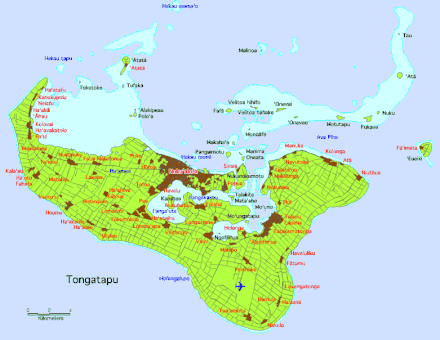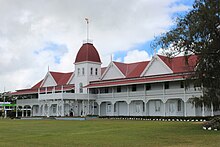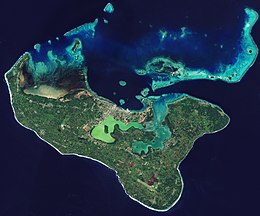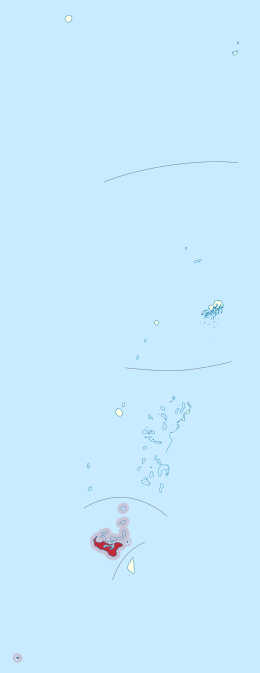|
Tongatapu
Tongatapu is the main island of Tonga and the site of its capital, Nukuʻalofa. It is located in Tonga's southern island group, to which it gives its name, and is the country's most populous island, with 74,611 residents (2016), 70.5% of the national population, on 260 square kilometres (100 square miles). Tongatapu is Tonga's centre of government and the seat of its monarchy. Tongatapu has experienced more rapid economic development than the other islands of Tonga, and has thus attracted many internal migrants from them. Geography The island is 257.03 square kilometres (99.24 square miles) (or 260.48 square kilometres (100.57 square miles) including neighbouring islands) and rather flat, as it is built of coral limestone. The island is covered with thick fertile soil consisting of volcanic ash from neighbouring volcanoes. At the steep coast of the south, heights reach an average of 35 metres (115 feet), and maximum 70 metres (230 feet), gradually decreasing towards the north.   North of the island are many small isolated islands and coral reefs which extend up to 7 kilometres (4.3 miles) from Tongatapu's shores. The almost completely closed Fanga'uta and Fangakakau Lagoons are important breeding grounds for birds and fish as they live within the mangroves growing around the lagoon's shores. The lagoons were declared a Natural Reserve in 1974 by the government.[citation needed] ClimateTongatapu has a rather cooler climate than the rest of Tonga as it is the southernmost group of islands in the country. Because of this, fruit production is lower in Tongatapu than it is in the warmer islands in the north.
HistoryPeople of the Lapita cultureTongatapu is known as having one of the highest concentration of archaeological remains in the Pacific. The earliest traces of Lapita pottery found in Tonga was from around 900–850 BC, 300 years after the first settlements in Tonga were established. Archaeologist David Burley discovered the pottery around the Fanga'uta Lagoon, 2,000 kilometres (1,200 miles) away from the Lapita pottery found at Santa Cruz in the Solomon Islands. Tonga was always the seat of the Tuʻi Tonga Empire, but in an area of distances up to 1,000 kilometres (620 miles), it was often only a symbolic rule. From the first capital at Toloa, around 1000 years ago, to the second capital at Heketā, at the site of the Haʻamonga ʻa Maui Trilithon, none boasts more traditional attractions than the third capital at Muʻa (from 1220–1851) with more than 20 royal grave mounds. Europeans Tongatapu was first sighted by Europeans on 20 January 1643 by Abel Tasman commanding two ships, the Heemskerck and the Zeehaen commissioned by the Dutch East India Company of Batavia (Jakarta). The expedition's goals were to chart the unknown southern and eastern seas and to find a possible passage through the South Pacific and Indian Ocean providing a faster route to Chile. The expedition set sail from Batavia on 14 August 1642. Tasman named the island "t’ Eijlandt Amsterdam" (Amsterdam Island), because of its abundance of supplies.[4] This name is no longer used except by historians. Commander James Cook, sailing the British vessel Resolution visited the island on October 2, 1773 by some accounts[5] and by other accounts[6] October 1774, returning again in 1777 , with Omai,[7] whereupon they left some cattle for breeding. These were still flourishing in 1789 when Bounty, under Fletcher Christian visited. The earliest mention of the name Tongatapu (spelled "Tongataboo" in the text) was by James Cook in 1777, as he wrote his memoirs for the Three Voyages Around the World, Volume 1. British and American whalers were regular visitors to the island for provisions, water and wood. The first on record was the Hope, in April–May 1807. The last known to have called was the Albatross in November–December 1899.[8]
Main sights
See also
References
External linksWikivoyage has a travel guide for Tongatapu.
|
|||||||||||||||||||||||||||||||||||||||||||||||||||||||||||||||||||||||||||||||||||||||||||||||||||||||||||||||||||||||||||||||||||||||||||||||||||||||||||||||||||||||||||||||||||||||||||||||||||||||||||||||||||||

